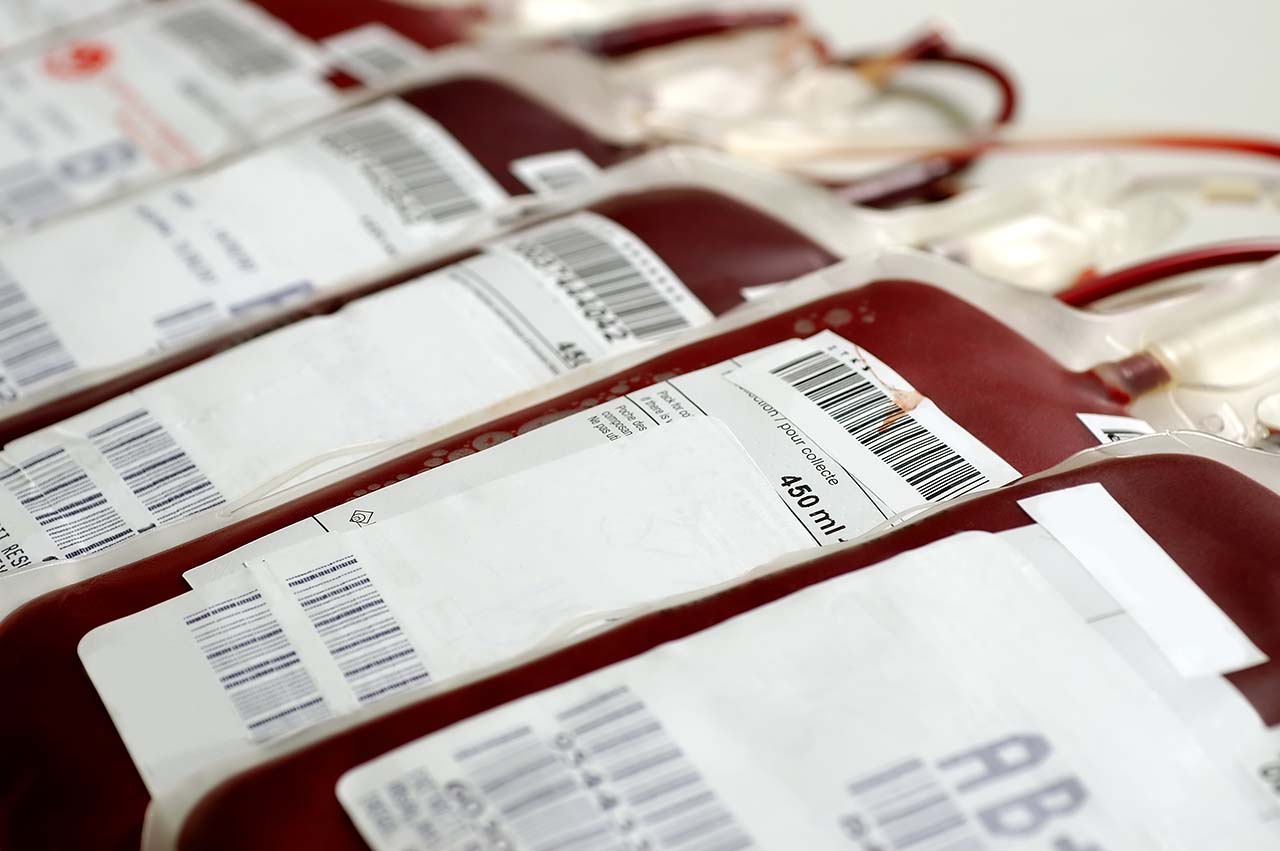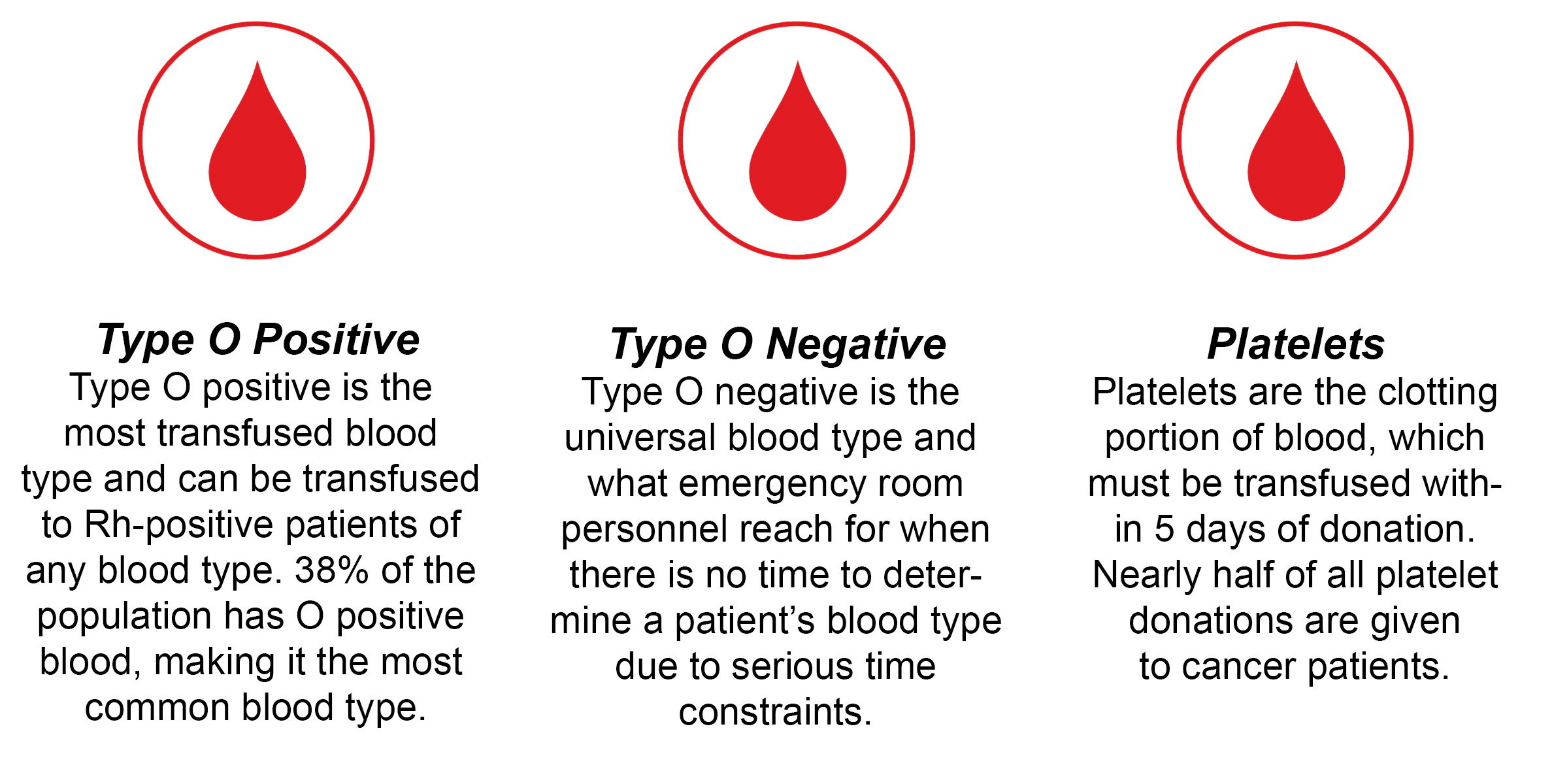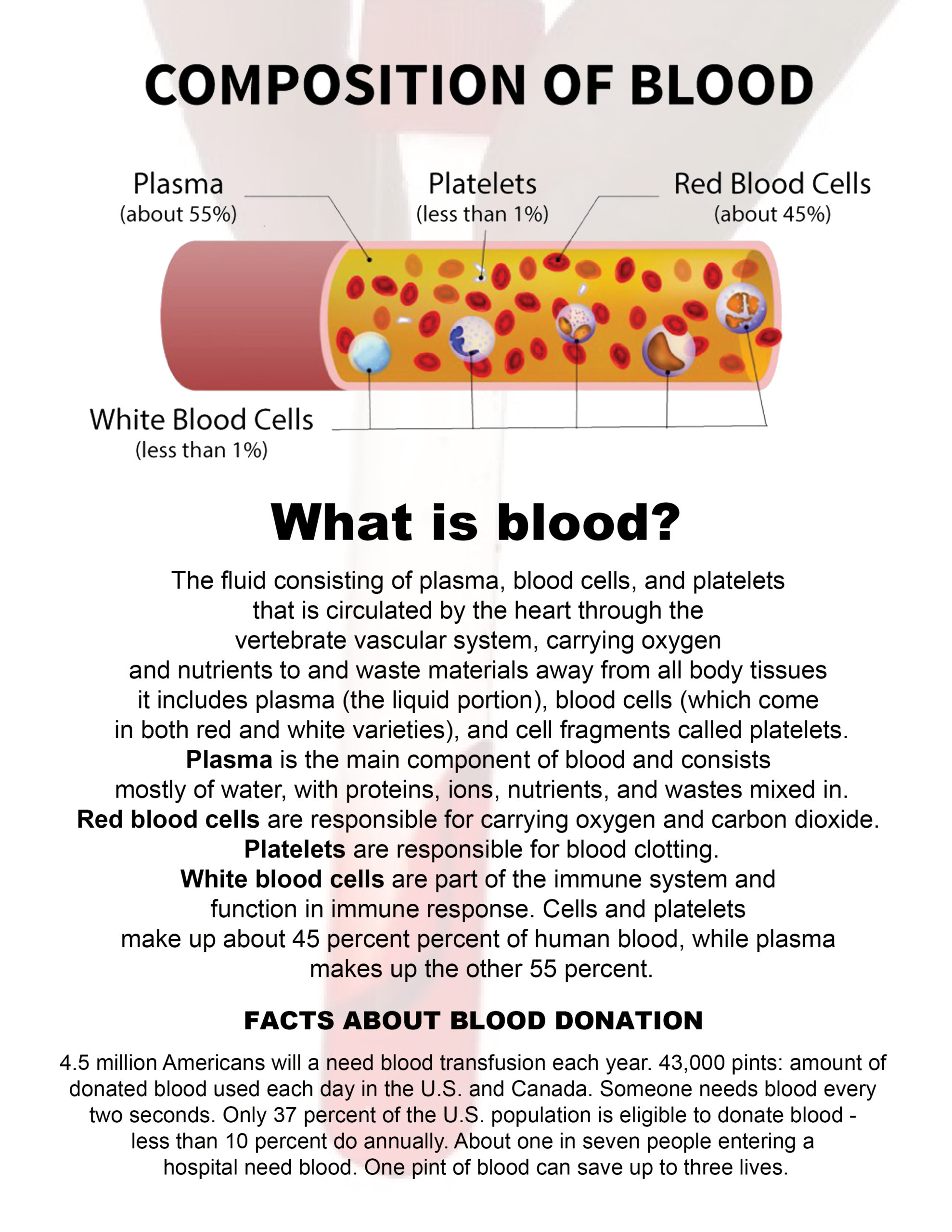
Learn CPR and Save Lives
February 3, 2022
Should I Take My Child to Urgent Care or an Emergency Room?
March 11, 2022by Susannah Wollman
Everyone at sometime in their life has suffered a pricked finger or skinned knee. When you look at the result, you see what appears to be a solid red liquid oozing (or flowing) from the wound. But looks can be deceiving!

Blood components
If you took that red liquid and put it under a microscope, you would see four components that make up blood in our bodies. The blood is a mixture of liquid and cells, plus macromolecules like protein and ions like sodium within the liquid. What are these, and what role do they play?
Merriam-Webster defines blood as “the fluid that circulates in the heart, arteries, capillaries, and veins of a vertebrate animal carrying nourishment and oxygen to and bringing away waste products from all parts of the body.”
Each of the four components that make up blood have a particular form and job to do. They are:
- Plasma is the main component, comprising 55% of blood and is mostly water, with proteins, ions, nutrients. and wastes mixed in.
- Red blood cells (which give blood its color) carry oxygen and carbon dioxide throughout the circulatory system.
- Platelets are the component that makes blood clot.
- White blood cells work with the immune system to fight infection.

More about blood components
If you place a tube of blood in a centrifuge and spin it at high speeds, the more dense red and white cells and platelets drop to the bottom of the tube and form red and white layers. Meanwhile, the plasma remains at the top and forms a layer of yellow liquid.
The ions, proteins, and other molecules in the plasma are crucial for maintaining blood pH and osmotic (the process where liquid moves through cells) balance. Albumin, the plasma’s main protein, plays a very important role.
There are molecules in plasma that have specialized functions. For instance, hormones in the blood act as long-distance signals. Antibodies are the security team, recognizing and neutralizing pathogens. And platelets floating around in the plasma are what makes blood clot so you don’t die from loss of blood. (Serum is plasma that has had the clotting factors removed.) Then we have lipids (a commonly known one is cholesterol) that are carried in plasma, but because they don’t dissolve in water must travel with escort proteins.
Down at the bottom of the test tube are the red blood cells (aka erythrocytes). These specialized cells are small and thinnest in the center. Their job is to carry oxygen to your body’s tissues. When they are mature, they do not contain mitochondria or a nucleus. As red blood cells travel through your lungs, they pick up oxygen which travels throughout your body. Along the way, the cells also pick up carbon dioxide. Some of the carbon dioxide binds directly to hemoglobin (the iron-containing respiratory pigment that gives blood its red color) that mixes with an enzyme that changes carbon dioxide into bicarbonate which dissolves in plasma into a gas that is carried back to the lungs to be converted back into carbon dioxide and released. Red blood cells have a lifespan of just 120 days. After that, the old or damaged red blood cells are broken down in the spleen and liver. New ones being produced in bone marrow then replace the dead ones.
The platelets (thrombocytes) are fragments of large cells called megakaryocytes that form 2000 to 3000 platelets that do the job of clotting blood. Platelets are attracted to areas where the lining of a blood vessel is damaged (remember your pricked finger and skinned knee?). These platelets form a sticky plug at the site of the injury and send out signals that attract other platelets. Not only do they also become sticky, but they activate a signaling cascade the converts fibrinogen into fibrin (a non-water soluble protein). These components form threads that knit together to reinforce the platelet plug.
Leukocytes (white blood cells) are not as common as red blood cells. These cells are primarily involved in immune responses, recognizing invaders such as viruses and bacteria and neutralizing them. White blood cells are also different from red ones in that they have both a nucleus and mitochondria.

So, why is it important to donate blood?
Four and a half million people need a blood transfusion every year in the United States. Blood is not something you can create in a laboratory, nor is there anything that can substitute for it. Unless you have a family member that shares your blood type standing by, you will need some donated blood ready at hand if you should need surgery or develop cancer. A single donor can help up to three patients.
There are several types of blood donations. A single unit of blood can undergo separation into its component parts for different uses. The most common donation is also the most flexible. It is called Whole Blood. Although it is collected in one pint, after being separated it can be used to help multiple patients.
Apheresis is the process that separates plasma from other blood components. It has blood clotting factors crucial to trauma patients and also for those fighting diseases like cancer.
Platelets are another component gathered through apheresis. After collecting the platelets, the red blood cells and other fluids are returned to the donor. Platelets are most often required by cancer patients.
Double red cell donation is also collected through apheresis. The process allows donors to give twice the amount of a whole blood donation. Anyone needing blood can use this type.

Give like your life depends on it.
In our hospitals today, most medicare relies on a steady supply of blood from donors. Millions of lives each year are saved by an adequate amount of blood which is needed in all health care facilities. Donating blood is a simple procedure that only takes about an hour.
Since the pandemic began, blood donations have dropped drastically, and now most hospitals and care facilities are facing blood shortages. Since March 2020, there has been a 10% overall blood donation decline. In 2018, student donors accounted for about 25% of donations. That number dropped by 62% to just 10% during the pandemic. Blood drive cancellations have been high due to illness, weather-related closures and staffing difficulties. With flu season upon us and the Covid variants, the loss of donations may compound the already bad situation.
The Red Cross supplies 40% of the nation’s blood supply and has had to make some problematic decisions lately. They have had to limit blood product distribution to hospitals, meaning some hospitals may not receive 1 in 4 blood products they so desperately need.
Most needed blood donation types

Donating blood during the Covid-19 Pandemic
Who can donate blood?
There is such an urgent need for blood during the pandemic that the FDA eased restrictions for certain groups of people. Instead of having to wait a full 12 months following restricted activity, the following groups can donate blood after three months.
- Male donors who have had sex with another man
- Women who have had sex with a man who has sex with another man
- Those who have gotten a tattoo or piercing recently
- Those who have traveled to an area where malaria is endemic.
The agency says the latest data indicate these changes won’t compromise the safety of the blood supply.
The Red Cross notes some other requirements to be eligible to donate blood. For whole blood donations you must:
- Be in good health and feeling well
- Be at least 16 years old in most states
- Weigh at least 110 pounds.
Those who must postpone blood donations for 28 days are those who:
- Have traveled to China, Hong Kong and Macau, Iran, Italy and South Korea
- Have a diagnosis of Covid 19, or come in contact with a person who has or is suspected to have the virus.
“There is no evidence that this coronavirus or any other respiratory viruses are transmitted by blood transfusions. Nevertheless, out of an abundance of caution, the Red Cross is using a robust health screening process for blood donors in the U.S., which consists of a temperature check, blood pressure evaluation, hemoglobin level test and a series of questions designed to ensure that a donor is healthy enough to donate,” says Jessa Merrill, director of biomedical communications for the humanitarian organization. “If a donor develops any symptoms of illness within the days following donation, donations are immediately quarantined and not used for transfusion.”

How to donate blood safely
“Other than being aware of any prescription medication you are currently taking and knowing your recent travel history, all donors should make sure to eat something and drink plenty of water before donating,” says Heather Moulder, director of marketing and public relations for The Blood Connection, a non-profit community blood center in Georgia, South Carolina and North Carolina.
“We are practicing social distancing at all of our centers and mobile drives by only allowing a certain number of people to be inside, and once they have checked in with our staff, we are asking donors to wait in their cars until there is a donor bed available for them,” Moulder says. That’s in addition to extra sanitizing and decontamination of surfaces within all Blood Connection centers and mobile units.
To ensure the health of employees, volunteers and staff, Merrill notes the Red Cross is taking a wide range of precautions, from disinfecting donor-touched areas to providing hand sanitizer that’s used before and during the donation process to following physical distancing practices by putting space between donors and donor beds, as well as waiting and refreshment areas.
“Individuals should contact blood donation centers to assess their personal risk of travel and personal interaction for the blood collection process,” says Robert Bednarczyk, an assistant professor of global health and epidemiology at Rollins School of Public Health at Emory University in Atlanta. “There is little risk involved with donating blood in the current pandemic.”



